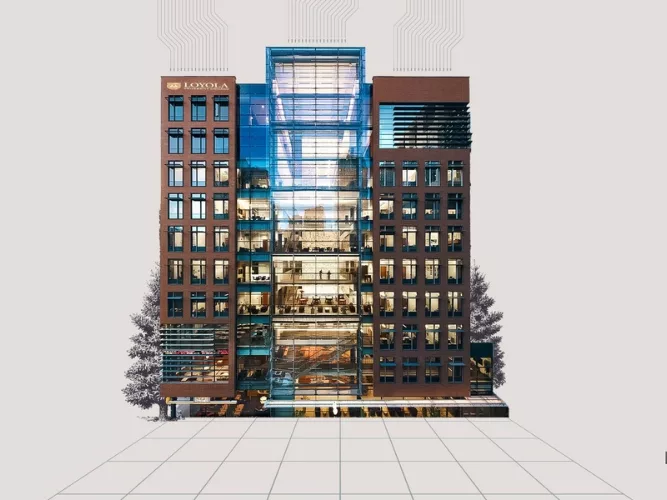BrainBox AI, a pioneer in autonomous AI technology for the built environment, is pleased to announce the significant results of its first Automated Emissions Reduction (AER) project in partnership with WattTime and The UC Berkeley Center for the Built Environment. In March 2021, BrainBox AI announced that it would be collaborating on a project funded by the Great Lakes Protection Fund, to help buildings located in and around the Great Lakes reduce the mercury and GHG emissions caused by their electricity use. Following the news release, its AI for HVAC tech, layered with its proprietary Automated Emissions Reduction (AER) algorithm, was deployed in one of Loyola University’s newest flagship buildings located in Chicago, Illinois. The goal of this deployment, using AER in conjunction with WattTime’s Marginal Operating Emissions Rate (MOER), was to reduce the energy consumed by the building, the emissions resulting from that energy use, while also facilitating the integration of renewable energy during increased congestion periods.
As the percent of total energy production from renewables grows, the need to manage energy distribution and consumption becomes more and more critical to avoid wasted renewable energy. WattTime’s MOER signal technology takes a granular view of electricity grids and forecasts the times when local electric grid experiences a surplus of renewables. During these congestion periods, transmission of some of the energy generated by these sources is intentionally reduced or stopped altogether. This act of letting this surplus energy generation go to waste is often referred to as a “curtailment”. Consequently, this phenomenon feeds the grid concerns pertaining to energy supply along with environmental and financial concerns related to the wasted renewable energy. The need arises for a solution that captures and stores this surplus energy to avoid this renewable waste. This is where BrainBox AI’s AER algorithm steps in. When deployed, it turns the building’s HVAC system into a thermal battery that can be charged on the renewable energy that would otherwise be wasted and discharged later when grid emissions are high. This unlikely battery is unlocked by an AI-driven algorithm making it much cheaper than electric batteries (e.g. Li-ion). It provides an elegant solution that turns buildings into an asset for electric grids while also helping to accelerate the growth of renewables.
“Our work on this project is a clear example of the impact that our autonomous AI tech, combined with AER, can have in grid energy management.” said Sam Ramadori, Chief Executive Officer at BrainBox AI. “We are excited by the fact that Autonomous AI opens a new chapter in building intelligence that unleashes greater opportunities and capabilities to support our transition towards full renewable energy.”
Over the course of a year, BrainBox AI’s autonomous AI-tech worked inside the LEED Gold certified Schrieber Center, a 10-story, 150,000 sq ft. building on the Loyola University campus. In a randomized controlled trial, the study compared three modes of the buildings management system (BMS) in relation to each other; results from the AER algorithm running paired with the BrainBox AI HVAC optimization algorithms, had the most impactful result. It showed that the building had achieved high returns related to CO2 emissions reductions, achieving a consistent 10% reduction in HVAC-related energy costs and emissions annually as well as reducing HVAC emissions by up to 15% during periods where renewables were being curtailed on the grid, plus a four-hour period after the curtailment ended. In addition, the test of the deployed AER algorithm revealed that the building itself could work as a viable unit for the storage of extra power during curtailment periods. “We're thrilled to see BrainBox AI bringing automated carbon reduction into existing commercial buildings.” said Geoff Hancock, Product Manager at WattTime. “Equipped with this technology, buildings can be a resource to better utilize renewables on the grid, which promotes faster renewable growth.”
In 2023, the results of this project were recognized by U.S.-based Center for the Built Environment as well as in a new ASHRAE Guide on the Role of Grid Interactivity in Decarbonization, marking yet another milestone for BrainBox AI and its pioneering technology for the built environment. “The Center for the Built Environment is excited about this study, its findings, and its potential as part of the solution to the challenges that the energy grid currently faces.” shared Paul Raftery, Professional Researcher at the Center for the Built Environment, University of California Berkeley.BrainBox AI has previously announced its work in this domain, in pilot projects and other initiatives, most notably when it entered and won the Tech for Our Planet Challenge at COP26 in 2021 under another pilot project. It continues to push the research and development of its AI-led technology further, driven by its mission to save the planet with AI. For a more in-depth account of the project and its results we invite you to read our case study.





